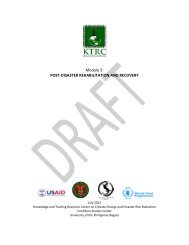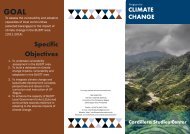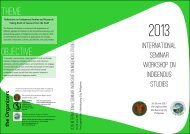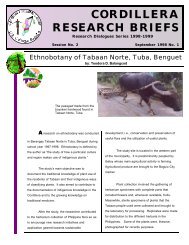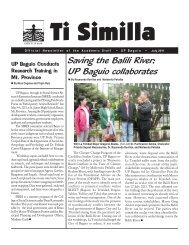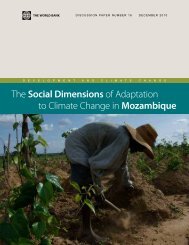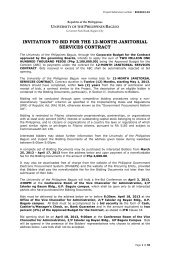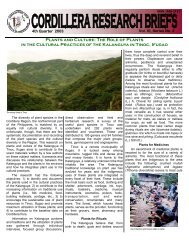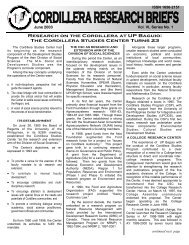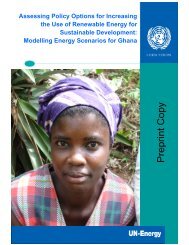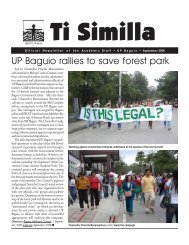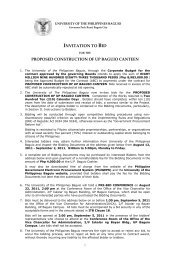Tanzania Report
Tanzania Report
Tanzania Report
You also want an ePaper? Increase the reach of your titles
YUMPU automatically turns print PDFs into web optimized ePapers that Google loves.
The second risk is that of increased cost<br />
and growing inefficiencies. Assuming that<br />
agreements are reached on a common approach,<br />
there is an additional risk that systems that could<br />
most effectively be established at a higher level,<br />
are being repeatedly created and established<br />
at a lower one. It will become increasingly<br />
important, as national and sub-national<br />
approaches develop, to ensure coordination<br />
and harmonization between actors at all levels,<br />
and to agree a common framework for MRV.<br />
Furthermore, it will be important to agree<br />
which MRV functions can be most effectively<br />
institutionalized at which levels to avoid the risk<br />
of increased cost and spiralling inefficiencies.<br />
Some of the key areas for the emerging MRV<br />
architecture include:<br />
• Role of local stakeholders and communities<br />
in MRV. As discussed above, locally-driven<br />
monitoring approaches appear to be both<br />
accurate and cost effective. As high-level<br />
discussions continue on the technical<br />
specifications of MRV systems, including<br />
choices of digital and GIS approaches, it<br />
will be important to consider how national<br />
demands for standardised data collection<br />
can be reconciled with participatory carbon<br />
and forest monitoring approaches.<br />
• The applicability of MRV models<br />
developed to date within the <strong>Tanzania</strong>n<br />
context. REDD+ places extremely high<br />
methodological demands in terms of MRV.<br />
This is complicated by the fact that in the<br />
absence of any global and legally binding<br />
agreement on REDD+, systems are in a<br />
state of flux and based on assumptions<br />
of what may or may not feature in any<br />
final convention. The methodologies for<br />
accounting for reduced deforestation and<br />
forest degradation are being developed<br />
•<br />
in many countries through externally<br />
funded pilot projects, often supported by<br />
international NGOs. The bulk of these<br />
efforts have been directed to areas with<br />
tropical high forest such as Brazil, Indonesia,<br />
Ecuador and some parts of Central America.<br />
In these areas it is often deforestation that<br />
represents the principle threat (through<br />
conversion to oil palm, through logging or<br />
other forms of planned use or conversion).<br />
In <strong>Tanzania</strong>, however, the threats to forest<br />
cover are largely driven by factors related to<br />
degradation, rather than deforestation. This<br />
includes illegal logging, charcoal production<br />
and small scale agriculture. Large scale<br />
conversion of forests to alternative nonforest<br />
uses is relatively rare, apart from a<br />
limited number of biofuel or agro-industrial<br />
production sites. This presents some<br />
challenges within the <strong>Tanzania</strong>n context<br />
for both projects and national level actors<br />
wishing to assess the impact of degradation<br />
as well as deforestation.<br />
Options for aggregation of carbon<br />
accounting and payments at project level.<br />
Forests managed and owned by village<br />
governments, community groups and<br />
individuals tend to be fragmented and<br />
dispersed, rather than in large, continuous<br />
blocks. This presents significant challenges<br />
for MRV processes within community-level<br />
projects and raises questions regarding the<br />
economic viability of REDD+ processes<br />
in these areas due to potentially high<br />
transaction costs. Pilot REDD+ projects<br />
currently being funded by the Norwegian<br />
government have recognized this constraint<br />
and are experimenting with various models<br />
that allow for transaction costs to be reduced<br />
through economies of scale.<br />
Participatory Forest Management and REDD+ in <strong>Tanzania</strong><br />
19





